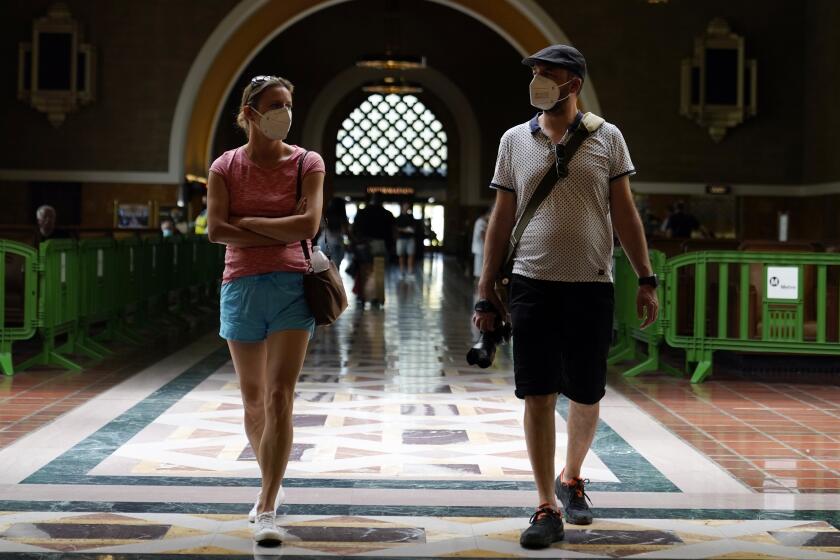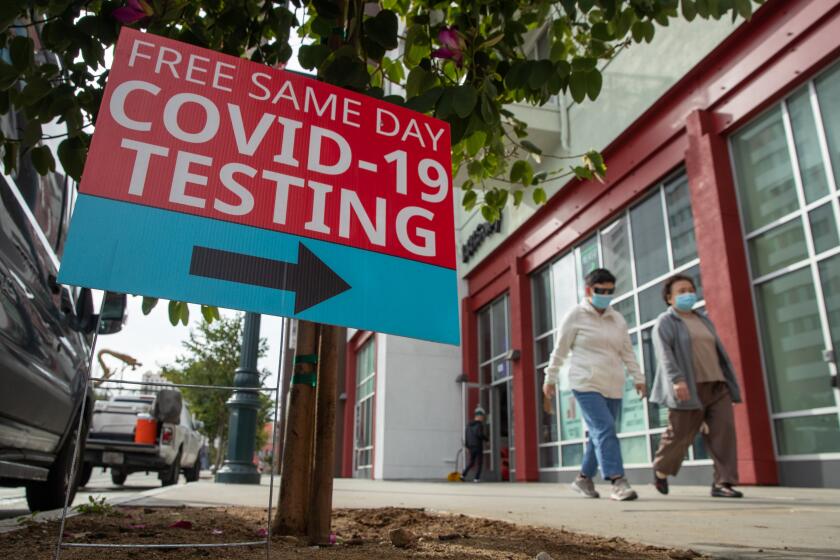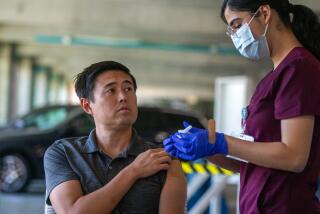‘The pandemic isn’t over.’ Coronavirus cases in L.A. County keep rising
- Share via
Experts say travel, the back-to-school season and new Omicron subvariants are the likely reasons why coronavirus cases are continuing to rise locally and across the nation.
- Share via
Coronavirus cases are continuing to rise locally and across the nation.
Experts say travel, the back-to-school season and new Omicron subvariants are the likely culprits. New outbreaks have been reported in Los Angeles County’s nursing homes, and one Hollywood studio temporarily imposed a mask mandate after several employees were infected.
Experts say the numbers remain low but are urging caution.
“The pandemic isn’t over,” Dr. Eric Topol, director of the Scripps Research Translational Institute in San Diego, said in a recent blog post.
Los Angeles County
In Los Angeles County, COVID-19 levels have risen for the fifth consecutive week.
Coronavirus-positive hospitalizations have been increasing in L.A. County. For the week that ended Aug. 19, there were an average of 422 such patients in hospitals per day, a nearly 30% increase from the prior week.
Coronavirus levels in county wastewater are at about 28% of the peak from last winter, during the region’s last significant spike. That concentration has been increasing since early July, when coronavirus levels were at about 8% of the winter peak.
With coronavirus transmission on the rise, the FDA said this year’s updated version of the COVID-19 vaccine is likely to come out by the middle of next month.
“While hospitalizations are increasing, the current levels are still far lower than what was seen in 2022 during the summer peak, when there was an average of 1,287 COVID patients hospitalized each day,” the L.A. County Department of Public Health said.
There were 39 new coronavirus outbreaks in skilled nursing facilities in L.A. County for the most recent week of data available, up from 20 the prior week.
“While resulting hospitalizations and deaths among skilled nursing facility residents are lower than at other points during the pandemic, nonetheless, increased transmission of COVID-19 at nursing homes carries heightened risk for frail elderly,” officials said.
One studio’s experience
A mask mandate was imposed on employees at Lionsgate headquarters in Santa Monica.
The policy change came after several employees tested positive for COVID-19, according to an internal memo. The change requires employees on two floors to wear a medical-grade face covering when indoors, unless actively eating, drinking or alone.
In L.A. County, workplaces, hospitals and other indoor settings with crowds of people are required to mask up when outbreaks occur, according to the Department of Public Health.
Amid the latest coronavirus uptick in California, health officials reiterate the same advice: Masks work, but it’s a personal preference whether to wear them.
The big picture
Nationally, there were 12,613 weekly COVID-19 hospitalizations for the week that ended Aug. 12 — double the number from the start of this summer, but just one-third the level at this time last year.
Areas of the country that are seeing particularly notable increases in new weekly COVID-19 hospitalizations are in the South, data from the Centers for Disease Control and Prevention show.
In California, there were 1,930 new weekly COVID-19 hospitalizations for the week that ended Aug. 12. That’s more than a 60% increase from the start of summer but still relatively low historically.
Updated versions and new vaccines for COVID-19, influenza and respiratory syncytial virus will be rolled out this fall.
What the experts are saying
Dr. Peter Chin-Hong, a UC San Francisco infectious-disease expert, said many people who have been infected with the coronavirus this summer did not require hospitalization, likely because they were vaccinated, had been previously infected or both. Even those who have been hospitalized generally require shorter stays than earlier in the pandemic, he said.
Still, hospitalized patients tend to be older and haven’t received a COVID-19 booster shot in the past year — meaning they are not considered “up to date.”
Topol described the recent increase in transmission as a “wavelet” that could pick up steam but is more likely related to waning immunity and behavior than the latest subvariants.
“The fact that the inexorable evolution of the virus continues — to find new hosts and repeat hosts — cannot be ignored,” he wrote.
“At the moment there’s no reason for alarm. ... What we’ll see in the weeks ahead is whether [variant] BA.2.86 takes hold or not. If it does, that will pose a new challenge, and make the ‘updated’ booster shots considerably less helpful than what was conceived when XBB.1.5 was selected as the target,” Topol wrote.
More to Read
Sign up for Essential California
The most important California stories and recommendations in your inbox every morning.
You may occasionally receive promotional content from the Los Angeles Times.


















